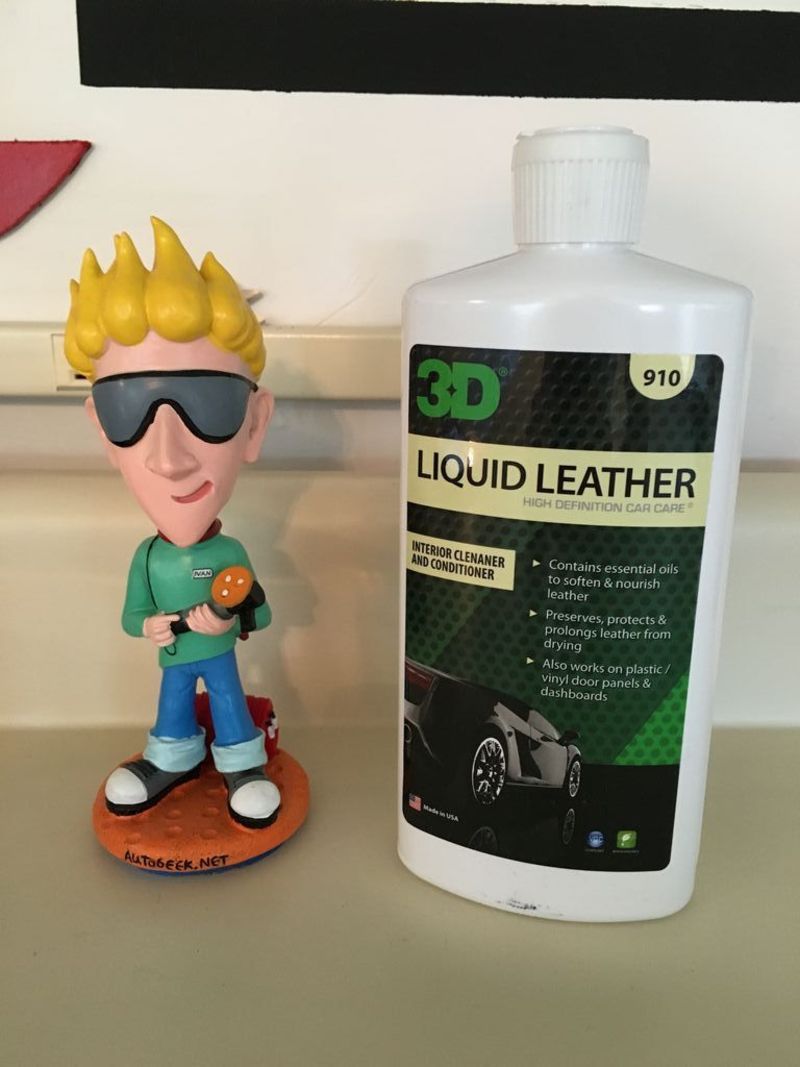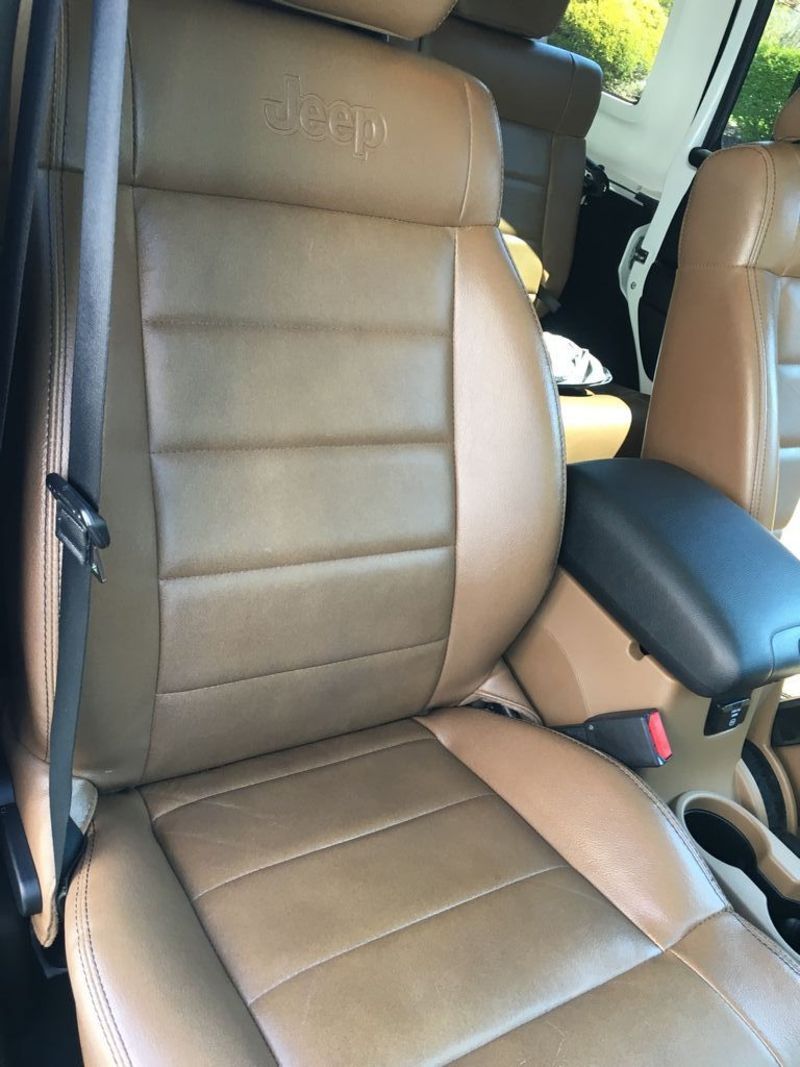The three most common types of automotive leather are:
Aniline: Leather that has been dyed and coated with a pigment (colored urethane paint) to yield uniform color and then clear coated. This type of leather does not reveal scars, pores and blemishes and has an artificial uniform grain pattern embossed. It is typically the only real leather in the seat and located only in the center inserts of the seat. The sides, bolsters, etc., are vinyl painted with the same colored urethane paint so it matches the leather inserts perfectly giving the entire seat a "leather" look. This is what 99% of cars have including Corvette, Escalade, newer Ferrari and Lamborghini. To demonstrate this just put a drop of water on your seat and see if it soaks in. It will not soak in as the leather has a painted on urethane coating on it. If water cant penetrate the coating how can "conditioners" and "protectants?" Read on.....
Semi-Aniline: Leather that has been dyed and coated with a semi-transparent pigment then clear coated This type of leather may reveal some of the underlying scars and blemishes of the hide as well as some color and grain changes. Almost never seen in the past twenty years.
Synthetic (aka vinyl): Much of the leather, and in some, all of the leather in many of todays vehicles is entirely synthetic or engineered leather. It looks like real leather but is really entirely synthetic. This is in use in some high ticket brands like Lexus, MB and Infinity for example. It is often difficult to tell what is real leather and what is engineered leather.
The bottom line is 99.9% of cars sold today have leather only on the middle insert of the seat bottom and back. The sides are completely 100% vinyl. The color and texture of the vinyl matches the leather inserts perfectly as they are all sprayed with a colored urethane coating. A perfect way to demonstrate they are vinyl is the water drop test outlined above. Another way is pull some of the seat siding out from underneath the seat. Notice there is a very thin foam or cloth backing? Real leather (from real cows) doesnt have foam backing on it.
Have you noticed the change in new car window stickers when referring to the seats? They now call the interior "leather lined," or "leather trim." Just take a look at a new C7 Corvette window sticker. They dont say "leather seats" like they used to. Now the C7 window sticker says, "Trim, Leather." This is because only the center inserts are actually leather! The remainder of the seat is vinyl. Remember, vinyl has a thin foam or cloth backing on it.
Everyone seems to like the term "conditioner," but just what is conditioning? When leather professionals speak of “conditioning leather” they are usually speaking about leather hydration. Properly hydrated leather will be soft, plump and flexible making it resistant to creasing and cracking. Most traditional conditioners are typically oily or contain silicone, wax or things like Aloe or Neats-foot or Mink oil. No protected, urethane coated, leather needs or benefits from these things. Conditioning products were initially designed for a much different type of leather like car seat who were 100% uncoated leather back in the 60s and 70s. Remember, none of these conditioners can absorb through the urethane coating making them useless.
Most conditioners leave a film on protected leather that can hasten the accumulation of soil. Dirt is attracted to the oil as it sits on top of the urethane coating and in the stitching. Your butt rubbing back and forth across this dirt acts like sandpaper and actually buffs the colored urethane coating off. This is frequently the cause of early bolster wear!
Conditioners do not penetrate the urethane painted top coat to condition the leather. True, some of the H2o in these conditioners evaporates and raises the relative humidity in the car cockpit which is beneficial as the leather will pick up the molecular H2o through the process of transpiration. Transpiration is the process by which moisture is carried through humidity to small pores on the underside of the leather/vinyl, where it changes to vapor and is released to the atmosphere. The leather/vinyl can absorb this through the untreated, underside of the material. However, a damp wipe down with a towel will do this as well and not leave that soil grabbing film.
Keep in mind that the colored urethane topcoat was added to the leather for the purpose of preventing spills and liquids from getting to the leather, as well as hiding the leather’s underlying scars, and blemishes, while making the leather more abrasion resistant. The urethane topcoat is colored so all of the surfaces of the seat match the door panels, dashboard, etc. If they did not contain coloring, every single piece of "leather" in your car would not match.
Leather conditioners do nothing to prevent stains or dye transfer. If your leather has developed cracks, using an oily conditioner may further degrade the adhesion of the painted topcoat around the crack and make the damage worse. Doesnt wet paper tear much easier than dry paper?
So how does this painted on protective urethane coating work and still allow the leather to stay hydrated? Much the same way as a rain coat would protect you from a driving rain. At the same time the rain is being repelled, you will begin to notice that your clothing is becoming damp due to the 100% humidity level. Thats basically how your leather stays hydrated, at the molecular level. If you want to test this put a drop of water on your protected leather in an inconspicuous place and leave for 15-20 minutes and you will see that it does not soak in. That is the urethane top coat preventing the absorption of the liquid as it was designed to do. H2o is a small molecule when compared to an oily conditioner so if water is not being absorbed by the leather, the larger molecules of a conditioner certainly are not.
Ok, so for those who insist that their leather feels softer after using a conditioner I can suggest three reasons for this. The first is that the conditioner has left an oily film on the leather and it altered the "hand" or feel of the leather. It has not really done anything to the leather, as it cant get to the leather, but it makes the hand feel nice for a short time until it is rubbed off or evaporates.
The other reason is that the conditioner likely contains a good deal of water and that it is raising the humidity level in the proximity of the leather. If this happens, the leather may absorb the water molecules and plump up and feel softer. The thing about this is that a wipe down with a wrung out watered cotton towel would accomplish the exact same thing.
The third reason is that the term conditioner has no defined meaning. Who knows what is in the bottle labeled Leather Conditioner? What one company calls a conditioner another might call a protectant. Whatever your "conditioner" is will just give you the impression the leather is softer when you touch it since it is slick. It is certainly not "conditioned" since it cannot absorb into the leather or vinyl portion of your seats. Bottom line is the industry has too many vague definitions as to exactly what "conditioning" is.
Leather is made soft in the tanning process and then sealed. You cannot add oils back through the urethane topcoat of protected leather. Leather becomes hard if it loses its needed hydration. Dry leather shrinks and feels hard. Much the same way a chamois gets hard when it is dry. Rehydrate the chamois and it becomes soft again. Rehydrate unprotected leather seats and they should soften to the degree designed in the original tanning process. Think about it.
I never use products that contain neats-foot, mink, or other oils, silicone, aloe, or any other odd, useless item, but often the labels doesnt tell you what is in the bottle. This includes Leatherique, Lexol, 303 Protectant, Armor All, Zaino, etc., etc. In my experience, these products do nothing but sit on top of the urethane top coating until your clothing wipes them off. In the meantime, they collect dust and dirt which is then ground into your seats and stitching as you slide across the seat getting in and out much like sandpaper. 90% of your seat damage comes from this!
In fact, page 212 of the C7 Corvette owners manual makes it clear that the only way to clean and treat the seats or other "leather" areas is with water and a mild soap - no cleaners or conditioners! More specifically, the manual states, "Use a soft microfiber cloth dampened with water to remove dust and loose dirt. For a more thorough cleaning, use a soft microfiber cloth dampened with a mild soap solution. Wipe excess moisture from these surfaces after cleaning and allow them to dry naturally. Never use heat, steam, or spot removers. Do not use cleaners that contain silicone or wax-based products. Cleaners containing solvents can permanently change the appearance and feel of leather or soft trim, and are not recommended. Soaking or saturating leather, especially perforated leather, as well as other interior surfaces, may cause permanent damage."
Dont you think GM would recommend leather cleaners and conditioners if the material was in fact all leather?
I vacuum the leather in my C6, Ferrari 360 and Lambo Gallardo and wipe it down with a wrung out watered towel weekly. That is it! Your leather will look like brand new for many years to come! My C6 is ten years old and the seats still look like brand new!
You are going to read a lot of people who make comments disagreeing with me. Just conduct the two above tests and make your own decisions. Does a drop of water soak into the seat or just sit on top until it evaporates? Does the backing of your seat material on the side pieces (bolster) have foam or cloth on the back? Remember, your seats may feel softer after applying a "conditioner," but go back in a day or two and see if they still feel that way. Once the conditioner dries on the seats and on your hands, this softness is gone!
Lastly, if Corvette seats are 100% leather, why has GM changed their description on MSRP window sticker as "Trim, Leather" and why do they recommend against use of leather cleaners and conditioners? Enuf said!






 Edit Post
Edit Post